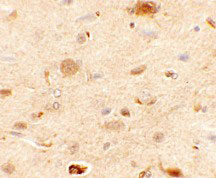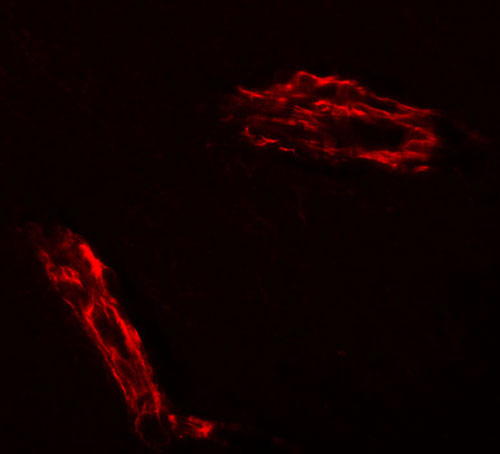EPAC1 Antibody
- SPECIFICATION
- CITATIONS
- PROTOCOLS
- BACKGROUND

Application
| WB, IHC-P, IF, E |
|---|---|
| Primary Accession | O95398 |
| Other Accession | NP_001092001, 10411 |
| Reactivity | Human, Mouse, Rat |
| Host | Rabbit |
| Clonality | Polyclonal |
| Isotype | IgG |
| Calculated MW | 103751 Da |
| Application Notes | EPAC1 antibody can be used for detection of EPAC1 by Western blot at 1 μg/mL. Antibody can also be used for immunohistochemistry starting at 2.5 μg/mL. For immunofluorescence start at 20 μg/mL. |
| Gene ID | 10411 |
|---|---|
| Target/Specificity | EPAC1 antibody was raised against an 18 amino acid synthetic peptide near the amino terminus of human EPAC1. The immunogen is located within amino acids 60 - 110 of EPAC1. |
| Reconstitution & Storage | EPAC1 antibody can be stored at 4℃ for three months and -20℃, stable for up to one year. As with all antibodies care should be taken to avoid repeated freeze thaw cycles. Antibodies should not be exposed to prolonged high temperatures. |
| Precautions | EPAC1 Antibody is for research use only and not for use in diagnostic or therapeutic procedures. |
| Name | RAPGEF3 |
|---|---|
| Synonyms | CGEF1, EPAC, EPAC1 |
| Function | Guanine nucleotide exchange factor (GEF) for RAP1A and RAP2A small GTPases that is activated by binding cAMP. Through simultaneous binding of PDE3B to RAPGEF3 and PIK3R6 is assembled in a signaling complex in which it activates the PI3K gamma complex and which is involved in angiogenesis. Plays a role in the modulation of the cAMP- induced dynamic control of endothelial barrier function through a pathway that is independent on Rho-mediated signaling. Required for the actin rearrangement at cell-cell junctions, such as stress fibers and junctional actin. |
| Cellular Location | Endomembrane system |
| Tissue Location | Widely expressed with highest levels in adult kidney, heart, thyroid and brain, and fetal kidney |

Thousands of laboratories across the world have published research that depended on the performance of antibodies from Abcepta to advance their research. Check out links to articles that cite our products in major peer-reviewed journals, organized by research category.
info@abcepta.com, and receive a free "I Love Antibodies" mug.
Provided below are standard protocols that you may find useful for product applications.
Background
EPAC1 Antibody: EPAC1, also known as Rap guanine nuclear exchange factor 3 and cAMPGEF-I, is widely expressed but most prominently in brain, heart, kidney, pancreas, spleen, ovary, thyroid and spinal cord. EPAC1 is a cAMP-binding protein with intrinsic guanine nuclear exchange factor activity that couples cAMP production to the activation of Rap, a GTPase belonging to the Ras family. This activation of Rap influences numerous cellular processes such as integrin-mediated cell adhesion, vascular endothelial barrier formation, and cardiac myocyte gap junction formation. Recently, EPAC1 has been suggested to also be involved in the cAMP-dependent regulation of ion channel formation, intracellular Ca++ signalling, ion transporter activity, and exocytosis.
References
de Rooij J, Zwartkruis FJ, Verheijen MH, et al. Epac is a Rap1 guanine-nucleotide-exchange factor directly activated by cyclic AMP. Nature 1998; 396:474-7.
Bos JL. Epac: a new cAMP target and new avenues. Hum. Immunol. 2004; 65:282-90.
Holz GG, Kang G, Harbeck M, et al. Cell physiology of cAMP sensor Epac. J. Physiol. 2006; 577:5-15.
If you have used an Abcepta product and would like to share how it has performed, please click on the "Submit Review" button and provide the requested information. Our staff will examine and post your review and contact you if needed.
If you have any additional inquiries please email technical services at tech@abcepta.com.













 Foundational characteristics of cancer include proliferation, angiogenesis, migration, evasion of apoptosis, and cellular immortality. Find key markers for these cellular processes and antibodies to detect them.
Foundational characteristics of cancer include proliferation, angiogenesis, migration, evasion of apoptosis, and cellular immortality. Find key markers for these cellular processes and antibodies to detect them. The SUMOplot™ Analysis Program predicts and scores sumoylation sites in your protein. SUMOylation is a post-translational modification involved in various cellular processes, such as nuclear-cytosolic transport, transcriptional regulation, apoptosis, protein stability, response to stress, and progression through the cell cycle.
The SUMOplot™ Analysis Program predicts and scores sumoylation sites in your protein. SUMOylation is a post-translational modification involved in various cellular processes, such as nuclear-cytosolic transport, transcriptional regulation, apoptosis, protein stability, response to stress, and progression through the cell cycle. The Autophagy Receptor Motif Plotter predicts and scores autophagy receptor binding sites in your protein. Identifying proteins connected to this pathway is critical to understanding the role of autophagy in physiological as well as pathological processes such as development, differentiation, neurodegenerative diseases, stress, infection, and cancer.
The Autophagy Receptor Motif Plotter predicts and scores autophagy receptor binding sites in your protein. Identifying proteins connected to this pathway is critical to understanding the role of autophagy in physiological as well as pathological processes such as development, differentiation, neurodegenerative diseases, stress, infection, and cancer.




